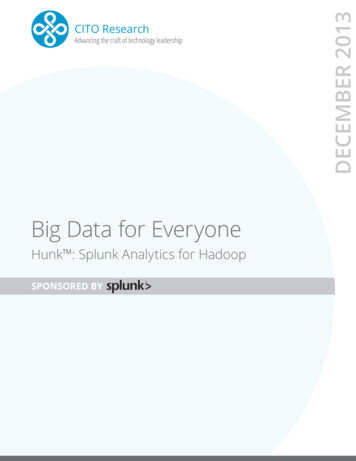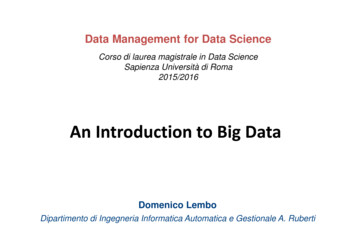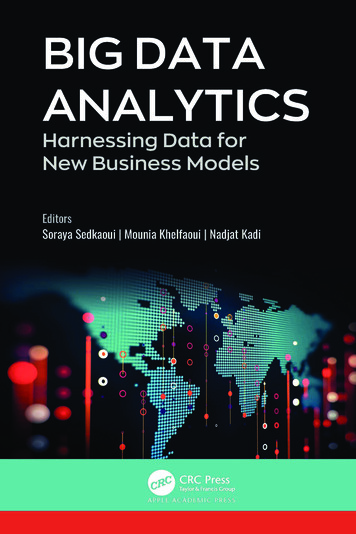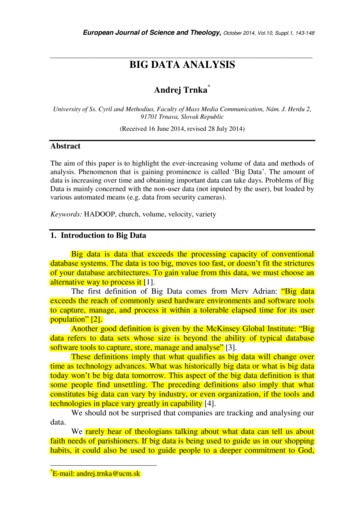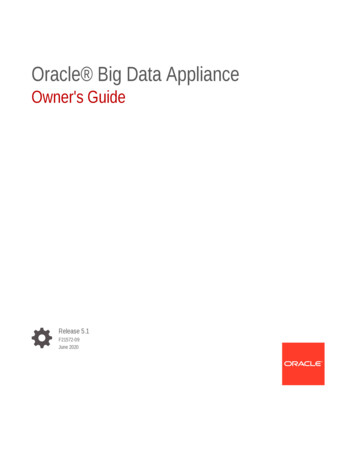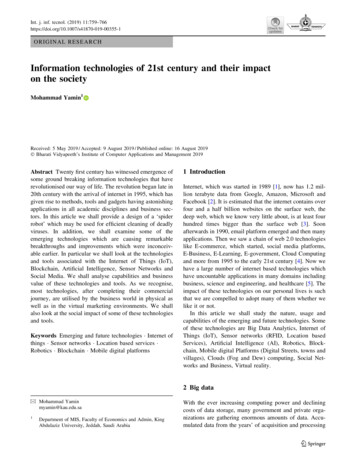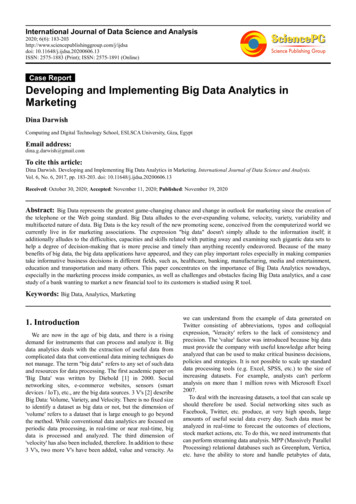
Transcription
International Journal of Data Science and Analysis2020; 6(6): sadoi: 10.11648/j.ijdsa.20200606.13ISSN: 2575-1883 (Print); ISSN: 2575-1891 (Online)Case ReportDeveloping and Implementing Big Data Analytics inMarketingDina DarwishComputing and Digital Technology School, ESLSCA University, Giza, EgyptEmail address:To cite this article:Dina Darwish. Developing and Implementing Big Data Analytics in Marketing. International Journal of Data Science and Analysis.Vol. 6, No. 6, 2017, pp. 183-203. doi: 10.11648/j.ijdsa.20200606.13Received: October 30, 2020; Accepted: November 11, 2020; Published: November 19, 2020Abstract: Big Data represents the greatest game-changing chance and change in outlook for marketing since the creation ofthe telephone or the Web going standard. Big Data alludes to the ever-expanding volume, velocity, variety, variability andmultifaceted nature of data. Big Data is the key result of the new promoting scene, conceived from the computerized world wecurrently live in for marketing associations. The expression "big data" doesn't simply allude to the information itself; itadditionally alludes to the difficulties, capacities and skills related with putting away and examining such gigantic data sets tohelp a degree of decision-making that is more precise and timely than anything recently endeavored. Because of the manybenefits of big data, the big data applications have appeared, and they can play important roles especially in making companiestake informative business decisions in different fields, such as, healthcare, banking, manufacturing, media and entertainment,education and transportation and many others. This paper concentrates on the importance of Big Data Analytics nowadays,especially in the marketing process inside companies, as well as challenges and obstacles facing Big Data analytics, and a casestudy of a bank wanting to market a new financial tool to its customers is studied using R tool.Keywords: Big Data, Analytics, Marketing1. IntroductionWe are now in the age of big data, and there is a risingdemand for instruments that can process and analyze it. Bigdata analytics deals with the extraction of useful data fromcomplicated data that conventional data mining techniques donot manage. The term "big data" refers to any set of such dataand resources for data processing. The first academic paper on'Big Data' was written by Diebold [1] in 2000. Socialnetworking sites, e-commerce websites, sensors (smartdevices / IoT), etc., are the big data sources. 3 V's [2] describeBig Data: Volume, Variety, and Velocity. There is no fixed sizeto identify a dataset as big data or not, but the dimension of'volume' refers to a dataset that is large enough to go beyondthe method. While conventional data analytics are focused onperiodic data processing, in real-time or near real-time, bigdata is processed and analyzed. The third dimension of'velocity' has also been included, therefore. In addition to these3 V's, two more V's have been added, value and veracity. Aswe can understand from the example of data generated onTwitter consisting of abbreviations, typos and colloquialexpression, 'Veracity' refers to the lack of consistency andprecision. The 'value' factor was introduced because big datamust provide the company with useful knowledge after beinganalyzed that can be used to make critical business decisions,policies and strategies. It is not possible to scale up standarddata processing tools (e.g. Excel, SPSS, etc.) to the size ofincreasing datasets. For example, analysts can't performanalysis on more than 1 million rows with Microsoft Excel2007.To deal with the increasing datasets, a tool that can scale upshould therefore be used. Social networking sites such asFacebook, Twitter, etc. produce, at very high speeds, largeamounts of useful social data every day. Such data must beanalyzed in real-time to forecast the outcomes of elections,stock market actions, etc. To do this, we need instruments thatcan perform streaming data analysis. MPP (Massively ParallelProcessing) relational databases such as Greenplum, Vertica,etc. have the ability to store and handle petabytes of data,
184Dina Darwish:Developing and Implementing Big Data Analytics in Marketingwhere the data is partitioned across several nodes with eachnode requiring processors / memory to process data. MPPdatabases, however, have an upper limit on storage space aswell as the same restrictions on data processing as SQL.Semi-structured data is data stored in a form other than tables(e.g. XML, JSON, etc.), and the NoSQL data store (NoSQLstands for Not Only SQL, implying that SQL-like querylanguages may also be supported) is a database managementsystem that offers a framework for storing and retrieving suchdata. Cassandra, HBase, MongoDB, and so on are examples ofNoSQL data stores. NoSQL data stores do not have a set staticschema for data to fit in, such as RDBMS, but they canaccommodate diverse data from various sources. BigTable [3]is a distributed storage system designed to handle massivesemi-structured data volumes, or it can be said that BigTable isa distributed NoSQL data system.While the amount of big data appears to attract the mostattention, a more acceptable description of big data is usuallygiven by the variety and velocity of the data. (Big Data is oftendefined as having 3 Vs: volume, variety, and velocity.) BigData cannot be efficiently analyzed using only conventionaldatabases or methods due to its size or structure. Big Dataconcerns require new techniques and technology for thestorage, management and realization of business advantages.These new tools and technologies allow large datasets and thestorage environments that house them to be created,manipulated, and managed. The McKinsey Global Reportfrom 2011 offers another concept of Big Data: Big Data is datawhose size, distribution, variety, and/or timeliness require theuse of new technological architectures and analytics to allowinsights that unlock new business value sources. Big Data:McKinsey & Co.; McKinsey 's concept of Big Data suggeststhat companies would need new data structures and analyticalsandboxes, new software, new analytical methods, and theincorporation of multiple skills into the data scientist's newposition. Several origins of the Big Data deluge are illustratedin Figure 1 [4].The Analytics Practice for Current business challengesprovide companies with many opportunities to become moreanalytical and data oriented, as seen in Table 1 [4]. Table 1describes four types of popular business challenges faced bycompanies where they have the potential to exploit advancedanalytics to generate competitive advantage. Organizationsshould apply advanced analytical methods to optimizeprocesses and extract more value from these commonactivities, rather than just doing regular reporting on thesefields. For several years, companies have been attempting tominimize customer turnover, boost revenue, and cross-sellclients. What is new is the chance to combine moderncomputational methods with Big Data in order to deliver moresuccessful studies for these conventional business problems.For decades, several enforcement and regulatory laws havebeen in place, but every year new provisions are introduced,which reflect increased operational complexity and datarequirements. Anti-money laundering and fraud preventionlaws require sophisticated analytical methods and techniquesfor proper enforcement and management. To approach themproperly, the four business drivers shown in Table 1 involve avariety of analytical techniques.While much is written about analytics in general, it isimportant to differentiate between BI and Data Science. Thereare many ways of comparing these classes of analyticalmethods, as seen in Figure 2 [4]. The time horizon and thekind of methodological methods being used are one way todetermine the kind of research being conducted. BI appears toinclude documentation, dashboards, and queries on businessquestions for the current period or in the past. BI systemsmake it easy to answer questions about quarter-to-date sales,progress towards quarterly objectives, and understand howmuch of a given product was sold in the previous quarter oryear. These questions appear to be closed-ended and describepresent or past actions, generally by somehow aggregatingand grouping historical data. BI usually addresses questionsrelated to "when" and "where" incidents took place. Bycomparison, in a more forward-looking, exploratory way,Data Science tends to focus on analyzing the present andallowing informed decisions about the future. A team may useData Science techniques such as time series analysis,Advanced Analytical Theory and Methods: Time SeriesAnalysis, instead of aggregating historical data to look at howmany of a given product sold in the previous quarter, toforecast future product sales and revenue more accurately thanto deal with more open-ended questions. Furthermore, DataScience appears to be more exploratory in nature and can useoptimization scenarios to answer more open-ended issues.This approach offers insight into current behavior andforesight into future events, while concentrating broadly ontopics related to "how" and "why" events occur. Where BIissues tend to involve highly structured information arrangedfor accurate reporting in rows and columns, Data Scienceinitiatives tend to use many kinds of data sources, includinglarge or unconventional datasets. Depending on the objectivesof an entity, if it reports and produces dash, it can choose toembark on a BI project. Current Analytical Architecture Asmentioned above, Data Science projects need workspaceswith scalable and agile data structures that are purpose-built toexperiment with data. Most companies do have datawarehouses that provide outstanding support for conventionalreporting and basic tasks for data processing, but sadly have atougher time supporting more rigorous analyses. A typicaldata architecture and some of the challenges it poses to datascientists and others attempting to do advanced analysis areshown in Figure 3 [4]. The data flow to the Data Scientist isshown, and how this person integrates into the process ofcollecting data to evaluate projects.Big information is making important new opportunities fororganizations to derive new price and make competitiveadvantage from their most worthy asset: info. For businesses,massive information helps drive potency, quality, andcustomized product and services, resulting in improved levelsof client satisfaction and profit. For scientific efforts, massiveinformation analytics modify new avenues of investigationwith doubtless richer results and deeper insights. In severalcases, massive information analytics integrate structured and
International Journal of Data Science and Analysis 2020; 6(6): 183-203unstructured information with real-time feeds and queries, gapnew ways to innovation and insight. This paper providesinformation about the importance of big data analytics forbusiness managers and information analytics for a gooddecision making, and also, a use case of bank customers isillustrated. The rest of the paper is divided as follows; section2 represents importance of Big Data analytics. Section 3represents Big Data Analytics implementation in companies,section 4 importance of Big Data analytics in marketing,section 5 represents opportunities and challenges for Big Data,section 6 concentrates on a case study of Big Data analytics inmarketing using R, and finally, comes the conclusion.Table 1. Advanced Business Drivers.Business DriverOptimize business operationsIdentify business riskPredict new business opportunitiesComply with laws or regulatory requirements185ExamplesSales, pricing, profitability, efficiencyCustomer churn, fraud, defaultUpsell, cross-sell, best new customer prospectsAnti-money laundering, Fair Lending, Basel II-III, Sarbanes-Oxley (SOX)Figure 1. What’s driving the data deluge.Figure 2. Comparing BI with Data Science.
186Dina Darwish:Developing and Implementing Big Data Analytics in MarketingFigure 3. Typical Analytical Architecture.2. Importance of Big Data AnalyticsBig Data is continuously, and at an ever-pace, beinggenerated. To establish a medical diagnosis, cell phones,social media, imaging technology, all these and more producenew data, and that must be processed for some reasonsomewhere. Diagnostic information that needs to be storedand processed in real time is automatically created by devicesand sensors. It is difficult to simply keep up with thisenormous data flow, but it is significantly more difficult toanalyze vast quantities of it, particularly when it does notadhere to conventional conceptions of data structure, torecognize meaningful trends and to extract useful information.The ability to change industry, government, research, anddaily life poses these challenges for the Big Data.Several industries have led the way in improving theircapacity to capture and manipulate information; Credit cardcompanies track every payment made by their customers andcan use rules derived by analyzing billions of transactions todetect fraudulent purchases with a high degree of accuracy.Mobile phone providers examine the calling habits ofcustomers to determine, for instance, whether the regularcontacts of a caller are on a competing network. The cellphone provider should proactively give the subscriber anopportunity to stay in its contract if the rival network offers anenticing promotion that might lead the subscriber to defect.Data itself is their primary commodity for companies such asLinkedIn and Facebook. These companies' valuations areheavily derived from the information they collect and host,which, as the information increases, includes more and moreintrinsic value.Three characteristics stand out as defining Big Datafeatures:1. Massive data volume: Big Data can be billions of rowsand millions of columns rather than thousands ormillions of rows.2. Complexity of forms and systems of data: Big Datarepresents the range of emerging data sources, formats,and systems, including digital traces left for subsequentreview on the web and other digital repositories.3. Speed of new data production and growth: high velocitydata can be represented by Big Data, with rapid dataingestion and near real time analysis. From many newsources, the Big Data trend is producing an immenseamount of knowledge. In order to take advantage ofthese opportunities, this data deluge requires advancedanalytics and new industry players, and new businesstrends.Evolving Big Data Ecosystem require a new analyticsapproach for organizations and data collectors to understandthat the data they can collect from individuals containsintrinsic value, and a new economy is evolving as a result.The market is seeing the emergence of data vendors anddata cleaners that use crowdsourcing (such as MechanicalTurk and GalaxyZoo) to test the effects of machine learningtechniques as this modern digital economy continues to grow.By repackaging open source software in a simplified way,and taking the software to market, other vendors provideadded value. For the open source platform Hadoop, vendorssuch as Cloudera, Hortonworks, and Pivotal have providedthis value-add. In this interconnected network, there are fourmajor groups of players as the new environment takes shape.These are shown in Figure 4 [4]. Data instruments and the"Sensornet" capture data from various locations and producenew information about this data on an ongoing basis. Foreach gigabyte of new data generated, an additional petabyteof data is produced about that data. For instance, considerplaying an online video game through a PC, game console orsmart device.The types of data and the associated market dynamicsdiffer greatly, as demonstrated by this evolving Big Dataecosystem. Sensor data, text, organized databases, andsocial media can be included in these databases. With this inmind, it is worth noting that in conventional EDWs(enterprise data warehouses), which were architected tostreamline and centrally manage reporting and dashboards,
International Journal of Data Science and Analysis 2020; 6(6): 183-203these datasets would not work well. Instead, to succeed, bigdata challenges, initiatives need distinct approaches. To getthe data they need inside an analytical sandbox, analystsneed to partner with IT and DBAs (database administrators).Raw data, aggregated data, and data with various kinds ofstructure are included in a standard analytical sandbox. Thesandbox allows for rigorous data exploration, and needs asavvy user in the sandbox environment to exploit and takeadvantage of data.Why data analytics efforts bog down before they get bigas recently as two or three years ago, data analytics leaders'main challenges were getting their senior teams torecognize their potential, finding enough talent to create187models, and creating the right data fabric to connect withinand outside the company databases together. But freshchallenges have arisen as these practitioners have pressedfor size. In several ways, many senior executivesconcentrated on open-ended attempts to learn newknowledge from big data. Analytics vendors and datascientists who were willing to take data and run all sorts oftests in the hope of discovering diamonds, which fueledthese efforts. Many managers have heard the claim "justgive us your information". Figure 5 [5] represents how toget big impact from Big Data Analytics for companies tobenefit from it.Figure 4. Emerging Big Data Ecosystem.Figure 5. Big Impact from Big Data.3. Big Data Analytics Implementation inCompaniesBig data exploded onto the scene in the first decade of the21st century, and the first organizations to adopt it were onlineand start-up companies. Firms like Google, eBay, LinkedIn,and Facebook were probably designed around big data fromthe beginning. They didn't have to reconcile or incorporate bigdata with more conventional data sources, and analyses
188Dina Darwish:Developing and Implementing Big Data Analytics in Marketingperformed on them, since they didn't have such traditionalforms. They did not have to combine big data technology withtheir conventional IT infrastructures, because they did notexist. Big data could stand alone, big data analytics could bethe only focus of analysis, and big data technologyarchitectures could be the only architecture. Consider,however, the status of big, well-established enterprises. Bigdata in these environments should not be isolated, but must beintegrated with everything else that's going on in the business.Big data analysis must coexist with other forms of dataanalysis. The Hadoop clusters have to operate alongside theIBM mainframes.Data scientists must somehow get along and work togetherwith mere quantitative analysts. To understand thiscoexistence [6], some 20 large organizations were interviewedin 2013 about how big data blends into their global data andanalytics environments. Overall, the anticipated co-existenceis noticed; in not one of these large organizations, big data washandled separately from other forms of data and analytics. Infact, integration has led to a new approach to analyticsmanagement, which we will call "Analytics 3.0."Some managers appreciate the creative value of big data,but they find it more "business as usual" or part of a constantprogression towards more data. They have been introducingnew types of data to their systems and models for many years,and they see nothing groundbreaking about big data. Putanother way, a lot of people were chasing big data before bigdata was big.Since the three aspects of big data are: the lack of structure,the possibilities raised and the low cost of the technologiesinvolved. This is consistent with the findings of a survey byNew Vantage Partners of more than 50 major corporations in2012 [6]. It was found, according to the survey summary: It'sAbout Variety, not Volume: the survey shows that businessesconcentrate on the variety of data, not on its volume, bothtoday and in three years. The most important purpose andpossible benefit of Big Data projects is the opportunity toevaluate different data sources and emerging data forms andnot to handle very large data sets.Companies that have long managed large data volumes arestarting to enthuse themselves about the potential to manage anew form of data, voice or text or log files or images or video.For example, a retail bank is getting a handle on itsmulti-channel customer interactions for the first time byreviewing log files. The hotel business analyses the customerlines with video analytics.In the 2017 Big Data Analytics Market [7], analysis isfocused on a cross-section of data covering geographical,functional, organizational and vertical industries. It assumedthat, unlike other industry analysis, this supports a morerepresentative sample and a better predictor of real marketdynamics. We have developed cross-tab analyses using thesedemographics to define and explain significantdevelopments in the industry. Geography North America,which includes the United States, Canada and Puerto Rico,constitutes 66% of the respondents, EMEA accounts for thesecond largest party (24%) followed by Asia Pacific andLatin America.Functions IT (36 per cent), Business IntelligenceCompetency Center (BICC) (18 per cent) and ExecutiveManagement (12 per cent) are the main categories offunctions in our Big Data Analytics study [7] (Figure 6).Examining patterns and actions by role lets us compare andcompare plans and goals in various areas of the organization.In Vertical Industries, Technology (14 per cent),Healthcare (12 per cent) and Financial Services (12 per cent)are the industries most represented in research [7], led byTelecommunications, Education and Consulting (Figure 7).Responses from consultants, who also engage more closelywith projects, and expand business awareness than manyconsumer peers do.In Big Data Analytics, value of Big Data amongtechnologies and initiatives considered to be strategic forbusiness intelligence, Big Data Analytics ranks 20 out of the33 topical areas are currently studied (Figure 8) [7]. It shouldbe noticed that 2016 was a landmark year for increasedadoption and perceived value of big data.Although we continue to assume that the interest in big datadiffers widely from organization to organization, a wider trendhas clearly emerged over the last 24 months. Contextually, wealso note that the perceived value of conventional BI activities,such as monitoring, dashboards, and end-user self-service, isstill a long way from big data. Figure 9 shows technologiesand initiatives to business intelligence, such as, Innovationsand Strategies, Strategic Business Intelligence, VideoAnalytics, Edge Computing, Internet of Things (IoT),Complex Event Processing (CEP), Open Source Applications,Social Network Monitoring (Social BI), Natural LanguageAnalytics, Text analytics, Cognitive BI (e.g., ArtificialIntelligence), Prepackaged vertical / functional analytical,Streaming data analysis, Ability to write transactionalapplications, Location intelligence / analytics Big Data ( ch-based framework, Data catalogue, Collaborationsupport for group-based.For the first time in 2017 [7], existing users of big data(which we describe as "systems that enable end-users toaccess and analyze data contained and managed within theHadoop ecosystem") have exceeded 50% (Figure 9). A further36 percent of respondents say they may use big data in thefuture. Just 11 percent of respondents have "no plans to use bigdata at all" (an all-time low). Unexpectedly, larger companies(those with more than 5,000 employees) are embracing bigdata technology such as Hadoop much quicker than smallercompanies. You would assume that smaller, youngerbusinesses would be more nimble and able to adopt newtechnology, but when it comes to big data, the opposite is thecase. It have been found [8] more than 300 major corporationsthat have made serious investments in Hadoop. On the otherhand, there are only 300 other businesses with 5,000 or lessworkers that are mature Hadoop consumers. Since there areten times as many small companies as there are, this meansthat in smaller companies, Hadoop has less than one-tenth ofthe reach it does in a large company. Many of the smaller
International Journal of Data Science and Analysis 2020; 6(6): 183-203Hadoop companies are high-tech, data-driven companiesthemselves. But, they are lagging behind perhaps because theycan't afford Hadoop and related technology, or it's becausethey can't pay the high wages ordered by data scientists anddata engineers, Or perhaps they just don’t have as much data.Figure 10 [9] shows adoption of Big Data tools.Data Scientists Need to Explore a large number of usecases for Hadoop and Spark in and around data science.Figure 11 shows the money spent on various Big Data cases[8]. A fast search [8] for "Data Scientists" on LinkedIn189reveals that there are 16,000 workers in the US. What issurprising is that there are a huge 5,000 open opportunitiesfor people with data science expertise. You will understandthe challenging disparity if you equate it to clinical scientistsin pharmaceutical companies. There are 3,200 medicinalscientists in the U. S., according to LinkedIn, but there arejust 200 work openings for that position around Americancompanies. Figure 12 [8] shows the number of data scientistsversus the number of job openings for data scientists,especially in the pharmaceutical industry.Figure 6. Main categories of functions in Big Data Analytics.Figure 7. Industries represented using Big Data Analytics.
190Dina Darwish:Developing and Implementing Big Data Analytics in MarketingFigure 8. Technologies and initiatives strategic to business intelligence.Figure 9. Adoption of Big Data.
International Journal of Data Science and Analysis 2020; 6(6): 183-203Figure 10. Adoption of Big Data tools.Figure 11. Money spent on various Big Data cases.191
192Dina Darwish:Developing and Implementing Big Data Analytics in MarketingFigure 12. The number of data scientists versus the number of job openings.4. Importance of Big Data Analytics inMarketingBig data is the greatest game-changing opportunity andparadigm change in marketing since the advent of the popularphone or the Internet. Big data refers to the ever-increasingvolume, velocity, variety, value and veracity of information.Big data is a crucial consequence of the modern marketingenvironment, born from the digital world we now live in, formarketing organizations. The term " big data "does not onlyrefer to the data itself; it also refers to the difficulties, skillsand competencies associated with storing and processing suchlarge data sets to enable a level of decision-making, that ismore reliable and timely than anything previously attempted;large data-driven decision-making.Organizations today face vast volumes of data, operationalcomplexity, rapidly evolving consumer behavior, andintensified competitive pressures. New technologies, as wellas rapidly expanding networks and platforms, have created avastly complex environment.Data worldwide is growing at 40% per year, a growth ratethat is good for any marketing and sales leader. Manymarketers may believe that data has always been huge, and insome ways it has always been huge. But think of the consumerdata hat companies gathered 20 years ago, sales transactiondata point, responses to direct mail promotions, couponredemption, etc. Customer data collected today, can be onlinepurchasing data, click-through rates, browsing habits, socialmedia interactions, mobile device use, geolocation data, etc.Big data can be thought of as a hidden ingredient, a rawmaterial and an integral element. It's not the individual datathat's so relevant. Instead, it is the knowledge gained from bigdata, the choices we make and the actions we take that makeall the difference. Three types of big data are the key tomarketing:1. Consumer: The most common big data category formarketing which include behavioral, attitudinal andtransactional indicators from such sources, as marketingstrategies, points of sale, websites, customer surveys,social media, online communities and loyalty programs.2. Operational: This broad data category usually containsquantitative indicators that assess the efficiency ofmarketing processes related to marketing activities,resource utilization, asset management, budgetarycontrols, etc.3. Financial: Usually located in the financial systems of theorganization, this big data category may include sales,expenses, income and other objective data forms thatassess the financial health of the organization.Having big data does not automatically lead to bettermarketing Organizations that wish to benefit in marketingfrom Big Data should do the following things:1. Effective exploration of new possibilities. Effectiveexploration involves the development of a dataadvantage by drawing the related data sets from bothwithin and outside the business. Analytics leaders needto step beyond general objectives such as "increasewallet share" and to a degree of detail that is relevant.They need to use digital knowledge to improve targetbuyers and use analytics to understand more about targetbuyers. Modern marketers should shed light on a moredifferent level of information, such as: which websitesare most commonly used by users, which social mediaaccounts they have and use, and also which buttons theypress on a website. With big data, "ideal customer
International Journal of Data Science and Analysis 2020; 6(6): 183-203profiles" can be easily targeted.2. Understand the journey of customer decision-making.Today's channel-surfing consumer, is comfortable usinga variety of devices, tools and technologies that fulfiltheir tasks. Understanding that the decision journey iskey to the discovery of battlegrounds, either
This paper concentrates on the importance of Big Data Analytics nowadays, especially in the marketing process inside companies, as well as challenges and obstacles facing Big Data analytics, and a case study of a bank wanting to market a new financial tool to its customers is studied using R tool. Keywords: Big Data, Analytics, Marketing 1.




